Reducing Time to Market for Electric Vehicles: Can This Be Achieved?
There are many unique technology features in modern electric vehicles, ranging from advanced cooling systems to electric transmissions, but one of the most important to electric vehicle manufacturers is the battery pack.
Altair has submitted this post.
Written by: Drew Buchanan, Senior Applications Engineer, TrueInsight (Altair Channel Partner)
I was riding my bike recently along Kelly Drive, a picturesque road along the Schuylkill River in Philadelphia, Pennsylvania, where I live. The road goes from the outskirts of the city into Center City and beyond. It was a beautiful day, and I was enjoying the sun and riverside views. As one of the more scenic roads in the city, it often lends itself to many cars traveling up and down its corridor. It is also known to be a good alternative route to the often-congested highway that runs next to it.

My bike along Kelly Drive.
While riding, I took note of how many vehicles were driving alongside me; surprisingly, the majority of them happened to be some type of fully electric or hybrid-electric vehicle. It is truly remarkable to see the transformation that is occurring in the automotive industry. I remember watching a documentary in the early 2000s with the apt title “Who Killed the Electric Car” and thinking at the time, “It’s a shame we won’t have any more electric vehicles.”
Well, fast-forward twenty years later, and now electric vehicles are prominent and thriving, as evidenced by my recent bike ride.
As a mechanical engineer, I am ecstatic to see the resurgence of electric vehicles and all the rapid engineering innovation that is happening in electric vehicle design. There are so many unique technology features in modern electric vehicles, ranging from advanced cooling systems to electric transmissions, but one of the most important to electric vehicle manufacturers is the battery pack. The battery pack provides the power necessary to move the vehicle, and the size and efficiency of a battery pack ultimately determine the range of a vehicle.
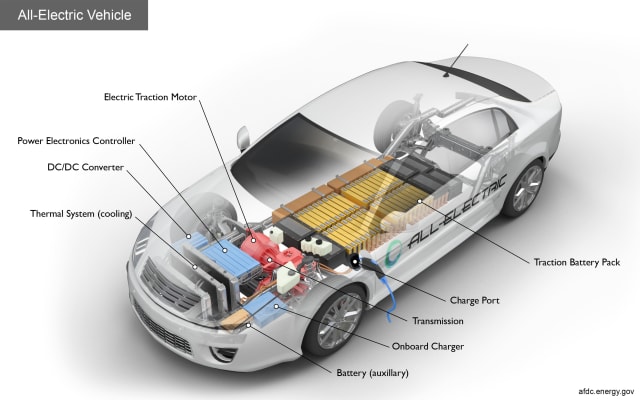
Example of an electric vehicle. (Image source: U.S. Department of Energy, Alternative Fuels Data Center, “How Do All Electric Cars Work?”)
Battery Pack Design Challenges
The battery packs in electric vehicles introduce a variety of design challenges for engineers, but one of the prominent challenges that designers deal with are the vibrations that these battery packs experience. In many cases the weight of battery packs can be 30 percent of the vehicle’s weight. For example, the total weight of a Tesla Model S is around 4,300 pounds, and the battery pack alone accounts for 1,200 pounds of the weight of the vehicle. The equation of motion indicates that large contributions of mass will ultimately increase forces incurred on an object. Therefore, vibrations are pivotal in electric vehicle design, and designers must factor in vibrations for effective battery pack design.

Equation of Motion. (M=Mass Matrix, C=Damping Matrix, K=Stiffness Matrix and F=Force)
As a result, several independent vibration standards have been put into place so manufacturers can test their battery systems for electric vehicles: ISO-6750, SAE-J2380, SAE-J2464, IEC-62660-2 and UN 38.3, to name a few. Each of these standards provide vibration profiles and assigned excitations which are derived from road measurement data. These vibration profiles can then be utilized in either physical testing or virtual testing to determine if there is any type of potential failure for the battery pack.
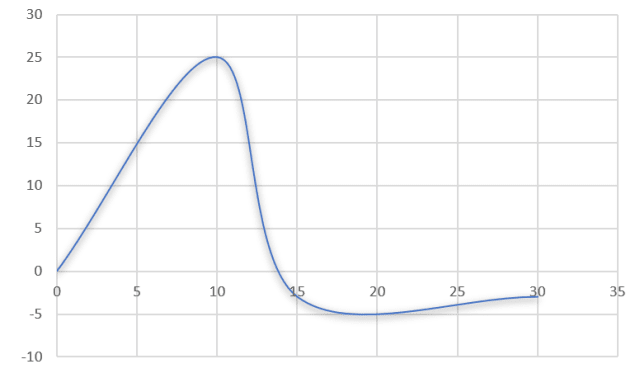
Vibration profile example: SAE J2464. (Image courtesy of TrueInsight.)
Current Electric Vehicle Battery Pack Testing
Vibration testing is currently performed through physical and virtual testing. Physical testing utilizes shaker tables where battery packs are placed on top, and a vibration profile from one of the vibration standards is applied. The table will then move the battery pack in a specified x, y or z direction. The battery packs will have this excitation applied for a specified amount of time to see if any type of failure occurs.
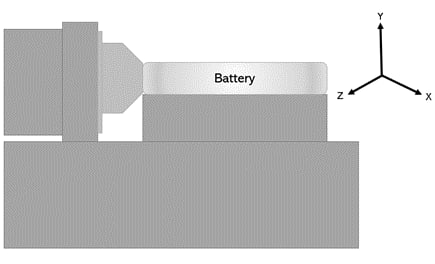
Example of a battery pack on a shaker table.
The challenge of physical testing is that electric vehicle manufacturers need to have a battery pack prototype in place to conduct the testing. If the battery packs fail during physical testing, engineers will have to go back and redesign the battery pack and then retest, which ultimately delays time to market. To eliminate this delay in time to market, virtual testing is utilized because it allows engineers to understand design failures without having to build a physical prototype.
Virtual testing can be conducted in a variety of ways, but one of the most common is finite element modeling. Finite element modeling is a numerical technique where assemblies and parts are discretized into small elements, and physical boundary conditions are prescribed on these elements. This means that engineers can model battery packs without having to build a physical prototype and test every condition that would be incurred during a physical testing scenario.
The challenge with running a finite element vibration scenario for battery packs is that typical battery packs contain hundreds of components which will increase the finite element count. A very large finite element count means more equations to solve, and thus a longer wait time for results. Designers running a vibration analysis using traditional finite element modeling may run scenarios for multiple hours or even days before obtaining results. As a result, battery pack virtual testing can be delayed by these long solve times.
Solving Vibration Finite Element Scenarios in a Fraction of the Time
Altair SimSolid has become an important finite element solution because it utilizes a meshless-based approach. Ultimately, this means that large assemblies can be solved in a fraction of the time versus traditional finite element tools. In the model below, I am going to simulate a battery pack that would be found on an electric vehicle and run through the process of setting up a typical vibration scenario.
SimSolid can import numerous CAD files from various external tools. In my case, I import my battery pack CAD model into SimSolid and I specify the material properties that I want to run in a vibration scenario. In SimSolid, I can run Modal Analysis, Transient Analysis, Frequency Response Analysis and Random Response Analysis. In this model, I select a Random Response Analysis which represents the dynamic behavior of a shaker table.
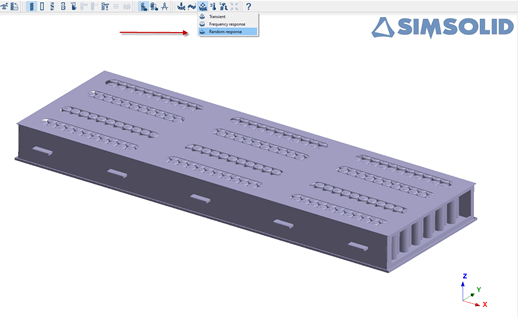
Battery pack in SimSolid and selection of random response analysis.
An advantage of SimSolid is that it can handle large assemblies with multiple connections via a streamlined GUI that can automatically detect connections. In the battery pack that I am utilizing, there are roughly 1,000 connections. SimSolid was able to automatically detect these connections in seconds, and I did not have to manually assign any of them, like I would have had to do in traditional finite element solutions.
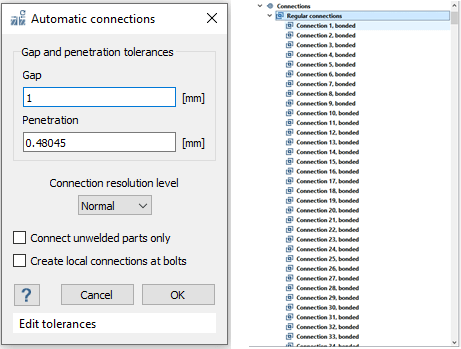
On the left, Automatic Connection GUI in SimSolid; on the right, the list of connections automatically created.
After specifying my connections, I need to key in the vibration profile and excitation to be applied in my system. SimSolid has an easy Applied Power Spectral Density (PSD) function GUI which enables users to key in or import PSDs directly. For this model, I am going to apply a PSD from ISO-16750. I then import the vibration profile from an Excel sheet, which contains the data points of the profile.
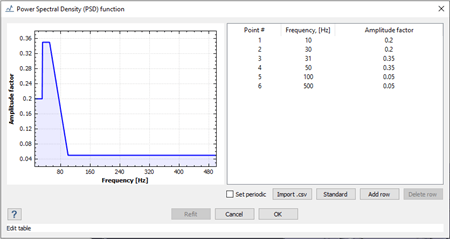
ISO-16750 vibration profile keyed in SimSolid.
After applying the vibration profile, I then need to apply the excitation. The excitation represents the amount of acceleration and the direction it will be applied in. It is important to note, the excitation works in conjunction with the PSD to represent the correct acceleration amplitude the battery pack will incur.
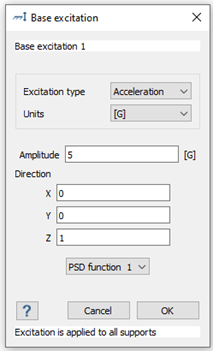
Excitation keyed in SimSolid.
At this point, my SimSolid model can be run. SimSolid runs this battery pack in a matter of minutes. For context, I ran this same battery pack model via a traditional finite element solver, and it took multiple hours to obtain the same results. Being able to run vibration scenarios in a fraction of the time is truly convenient. I can look at the displacement and RMS stress results to see if my battery pack meets my design objectives. In my case, the displacement and stress results do meet my design objectives, so I can feel confident about utilizing this battery pack design.
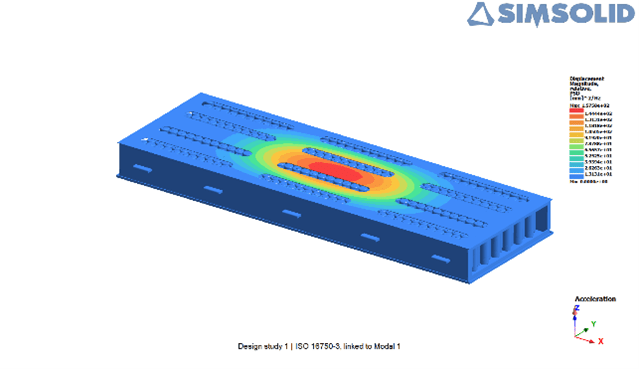
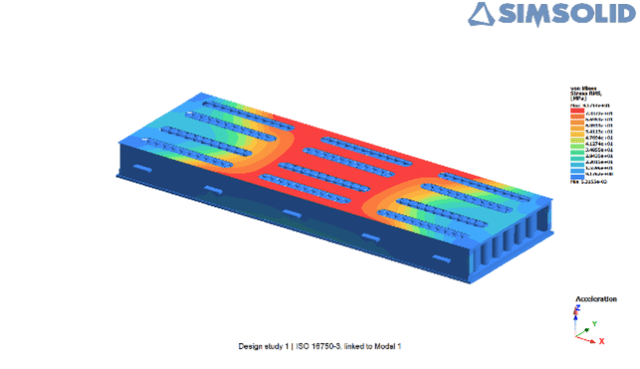
Displacement and stress results of battery pack from SimSolid.
As I think about where the world is headed, I am very excited about the resurgence of electric vehicles. I know designers can utilize tools like SimSolid to bring them to market sooner.
To learn more about SimSolid and other simulation-driven design tools, visit Altair.com/structures.








